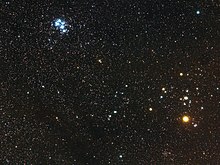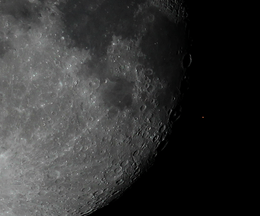Aldebaran
Based on present day observations, the position of Aldebaran has shifted 7′ in the last 2000 years; roughly a quarter the diameter of the full moon.
Follow-on measurements of proper motion showed that Herschel's companion was diverging from Aldebaran, and hence they were not physically connected.
However, the companion discovered by Burnham had almost exactly the same proper motion as Aldebaran, suggesting that the two formed a wide binary star system.
[33] Working at his private observatory in Tulse Hill, England, in 1864 William Huggins performed the first studies of the spectrum of Aldebaran, where he was able to identify the lines of nine elements, including iron, sodium, calcium, and magnesium.
In 1886, Edward C. Pickering at the Harvard College Observatory used a photographic plate to capture fifty absorption lines in the spectrum of Aldebaran.
By 1887, the photographic technique had improved to the point that it was possible to measure a star's radial velocity from the amount of Doppler shift in the spectrum.
By this means, the recession velocity of Aldebaran was estimated as 30 miles per second (48 km/s), using measurements performed at Potsdam Observatory by Hermann C. Vogel and his assistant Julius Scheiner.
[35] The extensive history of observations of Aldebaran led to it being included in the list of 33 stars chosen as benchmarks for the Gaia mission to calibrate derived stellar parameters.
[6] Its spectrum shows that it is a giant star that has evolved off the main sequence band of the HR diagram after exhausting the hydrogen at its core.
[41] With its slow rotation, Aldebaran lacks a dynamo needed to generate a corona and hence is not a source of hard X-ray emission.
[43] Beyond the chromosphere of Aldebaran is an extended molecular outer atmosphere (MOLsphere) where the temperature is cool enough for molecules of gas to form.
This region lies at about 2.5 times the radius of the star and has a temperature of about 1,500 K. The spectrum reveals lines of carbon monoxide, water, and titanium oxide.
[41] Outside the MOLSphere, the stellar wind continues to expand until it reaches the termination shock boundary with the hot, ionized interstellar medium that dominates the Local Bubble, forming a roughly spherical astrosphere with a radius of around 1000 au, centered on Aldebaran.
Some surveys, for example Gaia Data Release 2,[45] have indicated that Alpha Tauri B may have about the same proper motion and parallax as Aldebaran and thus may be a physical binary system.
These measurements are difficult, since the dim B component appears so close to the bright primary star, and the margin of error is too large to establish (or exclude) a physical relationship between the two.
[64] Irish singer and composer Enya has a piece released on her eponymous album in 1986, which lyricist Roma Ryan titled Aldebaran after the star in Taurus.
The name Aldebaran or Alpha Tauri has been adopted many times, including The star also appears in works of fiction such as Far from the Madding Crowd (1874) and Down and Out in Paris and London (1933).
It is frequently seen in science fiction, including the Lensman series (1948–1954), Fallen Dragon (2001) and passingly in Kim Stanley Robinson's "Blue Mars" (1996).
[67] A well-known example is the German conspiracy theorist Axel Stoll, who considered the star the home of the Aryan race and the target of expeditions by the Wehrmacht.
[68] The planetary exploration probe Pioneer 10 is no longer powered or in contact with Earth, but its trajectory is taking it in the general direction of Aldebaran.
[69] The Austrian chemist Carl Auer von Welsbach proposed the name aldebaranium (chemical symbol Ad) for a rare earth element that he (among others) had found.




